Welcome to the week.
Here are the most notable stories our writers and readers came across in the past seven days…
Sad but true: Parody about DOTs and crosswalks that is so close to the reality and so timely that it’s almost not funny. (The Onion)
Idaho Stop for all!: At a major Vision Zero conference, a federal administrator who works for NHTSA said they’ve analyzed data from places with “stops as yields” laws for bike riders and they like what they see. (Streetsblog USA)
E-bike style: For an American e-bike brand to truly go mainstream it must be stylish and sexy like the brand VanMoof. (New York Times)
Great question: I’m just happy to see the automotive media even asking whether or not a separate license should be required for driving some types of consumer vehicles. (The Drive)
Transit attitudes: This large survey of Washington D.C.-area commuters should be a wake-up call for city planners and add even more urgency to efforts to make driving worse while we improve transit service substantially. (Washington Post)
Tech, part one: Audi thinks they’ve found a way to make cycling safer through a high-tech communication protocol that can ping drivers and bike riders before a collision. (Curbed)
Tech, part two: As part of their vision zero campaign, London city planners worked with a company to insert sensors onto bikes in a bid to find hot-spots and other danger warning signs. (See Sense)
Tech, part three: Noted transportation journalist David Zipper says despite enthusiasm from carmakers, Advanced Driver Assistance Systems won’t lead to safety utopia. (The Verge)
Bike subsidies: The City of Denver has spent over $4 million to help people by e-bikes and it’s been so successful backers of the program are asking for more money to keep it rolling. (Fast Company)
Cycling through Covid: Researchers John Pucher and Ralph Buehler give the City of Portland high marks for helping folks continue cycling through the pandemic. (Streetsblog USA)
Video of the Week: The inimitable filmmaker Casey Neistat returns to one of his pet peeves with a proposal to finally fix it…
Thanks to everyone who shared links this week.

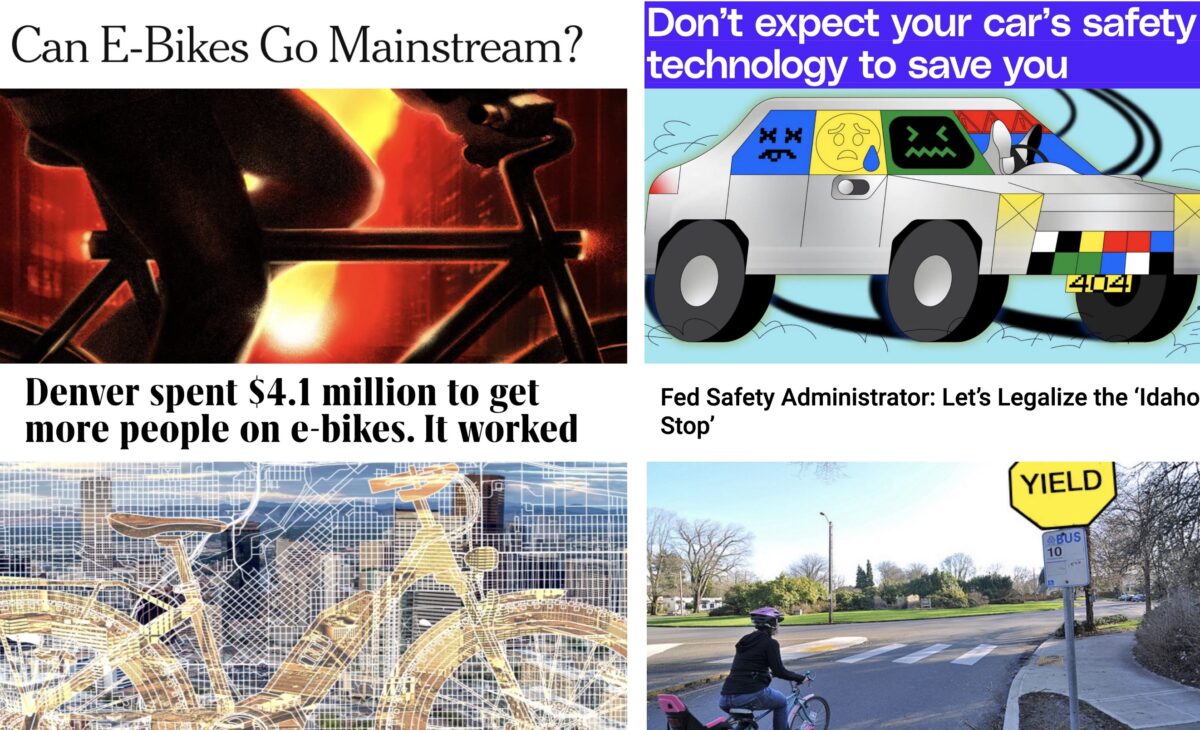
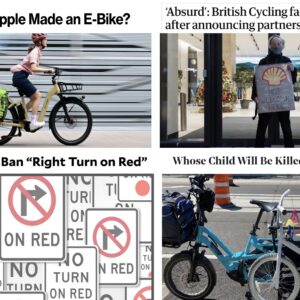
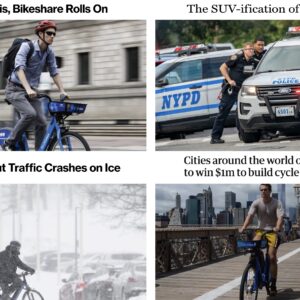
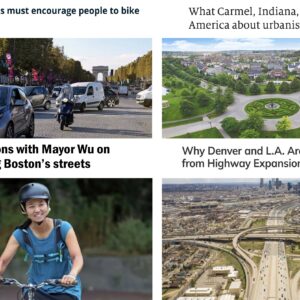
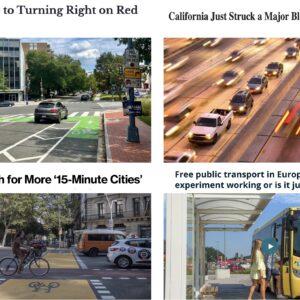
Thanks for reading.
BikePortland has served this community with independent community journalism since 2005. We rely on subscriptions from readers like you to survive. Your financial support is vital in keeping this valuable resource alive and well.
Please subscribe today to strengthen and expand our work.
The link for Fast Company (Denver bike subsidy) is opening a Curbed article. I think the link below is the article.
Denver spent $4.1 million to get more people on e-bikes. It worked (fastcompany.com)
e-Bike riders should be required to attend training to ride these dangerously fast vehicles and have a permit to own one along with a license.
Can we put governors on all cars first? Speeding drivers lead to far more injuries and deaths than irresponsible e-bike riders. E-bikes have limiters how can they be going dangerously fast but drivers are just fine?
Seriously if we have limited resources and time why would we waste it on something so trivial.
Interesting take. Most of the ebikes I see on the road appear to be class 1/2 (top speed of 20mph), and except for accelerating from a dead stop or going up a hill I can keep up with or even pass many of them on my normal (non-motor assisted) bike. I could possibly get on board with restrictions to Class 3 ebikes (<28mph), since some other countries already ban those. But I get the feeling you’re not really interested in a nuanced discussion about this, so…
We already do have restrictions on Class 3 ebikes. They are not legal to ride in bike lanes or bike paths in Oregon. You basically have to travel as if you were a motor vehicle if you’re riding a Class 3 ebike. Which I think is appropriate. 20 is plenty!
So “I didn’t see you” will be replaced with “My alert didn’t go off” (not I didn’t hear it, the driver will squarely lay blame on the technology that’s supposed to be paying attention for them).
“So and So died in a collision with a motor vehicle, he was not wearing a helmet” will be replaced with “so and so died in a collision, he was not equipped with a beacon”
Because a beacon equipped light that costs more than my town bike is going to be ubiquitous? Shoot, lights aren’t and they’re way cheaper.
My Boise contacts say Idaho Stop ain’t what it used to be now that Boise has become “the city of cars” rather than “the city of trees.” Lots more “accidental” run-downs. The newcomers aren’t used to Idaho Stop, and don’t seem to care about getting used to it.
It may not be what it used to be there but there’s a ton more evidence that the less time spent at an intersection the safer it is for cyclists. It’s pretty clear that if you can get through an intersection safely by rolling a stop sign or going against a red you’re better off than waiting for your turn. Bonus it’s faster for everyone cyclists and drivers.
Re: NYT sexy e-Bike
I don’t think that style alone is going to make E Bikes go mainstream. Yes, there will be people who chose to buy something for the style, but those are people who have the means to choose that.
There’s also never going to be one single factor that will make E-Bikes go mainstream. We need infrastructure, cheeper batteries, etc.
In my mind, some of the real keys, are affordability, reliability, and practically. One thing that “bike people” and “car people” have in common is a willingness to dive into the features of their desired object. They can get joy and appreciate small design details of something. But there are very few “car people”. Most people in the US who own cars view them as something they need to move them from place to place. Most people don’t much care about horsepower, or small design details.
The same is true in the Netherlands. Most people who ride bikes aren’t “bike people”. They view them as something they need to move around from place to place. Most people don’t care about gear ratios, or small design details.
Look at the most common features on bikes in the Netherlands, fully inclosed chain guards, internally geared hub (if they have gears), drum brakes, upright riding position, fenders, built in light dynamo, often heavy but reliable. They are designed to be simple, and you don’t have to think much about them.
That’s the design philosophy needed with ebikes to get them to go mainstream. Make it simple, reliable, and something that you can use without to much thought. Make it a seamless part of everyday life.
I appreciate a lot of what the NYT does, but they often completely miss the mark on pieces like this. Maybe they only talk to one person, or a very small group, and then they attempt to build a long-form article on it. It can be laughably inaccurate at time.
The Dutch have a culture of thrift, minimalism, and a conformist worship of “tradition” so it’s no surprise that the classic Dutch bike uses materials and designs that date to the turn of the last century. IMO, it’s inevitable that electric bikes will transition away from current 80+ lb boat anchor designs towards something a little more modern and elegant.
It’s so #$%ing typical that basic safety systems with a proven track record, such as, automated emergency braking and intelligent speed assistance are dismissed as being ineffective by SUV-centric USAnian pundits. These systems have a proven track record of reducing traffic deaths and are mandatory for all vehicles in the EU (with more stringent regulation for large vehicles):
https://road-safety-charter.ec.europa.eu/resources-knowledge/media-and-press/intelligent-speed-assistance-isa-set-become-mandatory-across_en
https://mobility21.cmu.edu/europe-mandates-automatic-emergency-braking/
https://etsc.eu/etsc-welcomes-provisional-deal-on-new-vehicle-safety-standards/
I welcome all regulation that slows down deadly SUVs/trucks, irritates inattentive drivers, and makes these vehicles more expensive.
The streetsblog article is so frustrating! It reflects PBOT’s way of of thinking about bike infra, and I suspect these points came directly from PBOT: From this perspective, success is measured in miles of protected bike lane added, or miles of greenway added, etc. regardless of it the new woork is effective. Obviously, this number (quantity or distance) is meaningless if the facilities are not connected well to the rest of the bike network (Blumenaur Bridge, Greeley Bike route, etc) or if they are redundant to the point of being useless (proposed greenways around Hawthorne). This is misplaced PR and PBOT does not desrve it. their designs and execution for the past 5 years has been really subpar. I hope PBOT did not have a hand in producing this fake news!
I know “there’s no accounting for taste” / “de gustibus non est disputandum”, but VanMoof makes some of the ugliest bikes I’ve ever seen. Definitely not stylish and sexy to my eyes.
Same here, I’ve only ever seen tech-startup looking bros ride VanMoof bikes. IMO Gazelle makes the best-looking ebikes.
Agree. They’re from that school of design where it’s like, “let’s make everything in the real world look like a stripped down icon of itself on your phone!”
RE Transit Attitudes
From the article:
When I read that, I do not see that as a call to arms to “add even more urgency to efforts to make driving worse”. Driving is not causing transit riders to lose satisfaction. Transit is doing that all by itself.
“Make driving worse” is the “defund police” of transit activism. It causes the progressive transit community to lose credibility with the rest of society and makes it harder for those of us who are trying to make things better (which, to your credit, you also call for).
Personally, I don’t see the current model of transit recovering any time soon. When automation arrives, I hope we’ll be able to replace it with something better that people will want to use.
I’m usually a MAX rider (hate that it’s become the wild wild west), but I decided I’d give the bus a chance today.
At my transfer center stop there was someone cooking meth(?) under the cover where I would have liked to have stood out of the rain in.
Yeah, TriMet, you suck.
I’ve taken a lot of public transit all over the place both pre and post pandemic, and the TriMet system, even today, is significantly safer and cleaner than most systems I have been on.
The DC Metro problems are a symptom of a system so thoroughly mismanaged that they had to remove more than half of their entire fleet of trains from service for more than a year. Headways went from like 5ish minutes or better to 15 to 30 on a fully-grade separated metro! Honestly it’s shocking to me that satisfaction isn’t at exactly 0%. DC Metro has been mismanaged to such a shocking degree, it’s infuriating. If your train fleet is so poorly diversified that it’s even possible for 50% or more of it to go out of service for a year, every executive responsible for that decision should be fired.
But I don’t really think there’s any long term reason to panic, DC Metro just has to do the sensible thing and regain public trust by running service people can rely on. Okay so maybe there is long term reason to panic, but it’s not as dire as a public opinion poll may seem despite the stupid circumstances.
Love the Video of the Week! I agree that is is “grimy’ to report your fellow citizens, but that is what it has come to in Portland and apparently NYC. I wish Portland would enact the county for idling and parking in bike lanes.